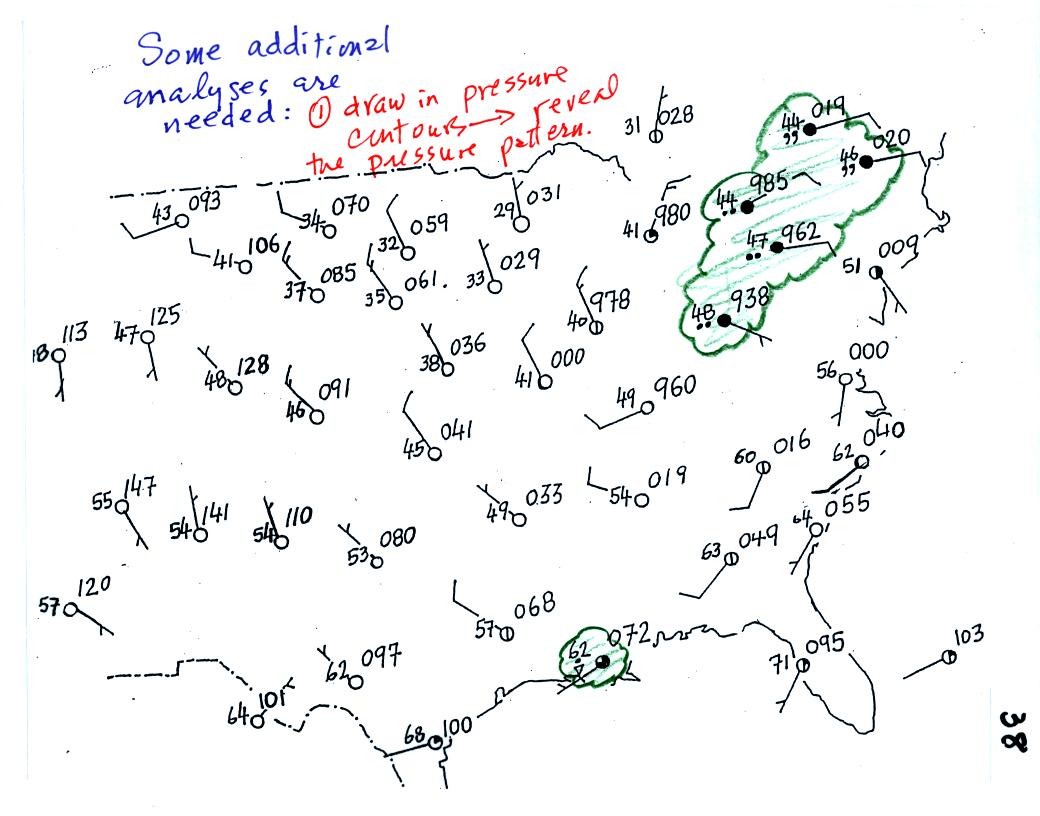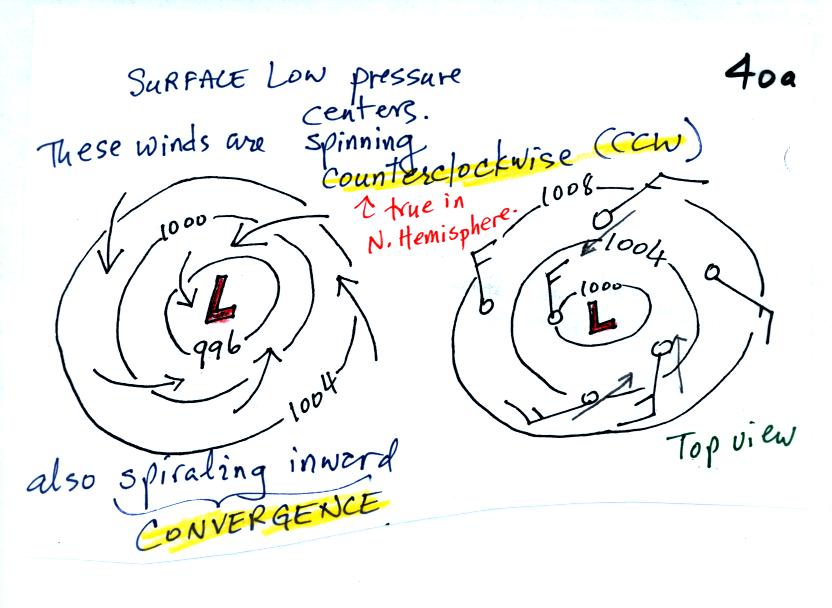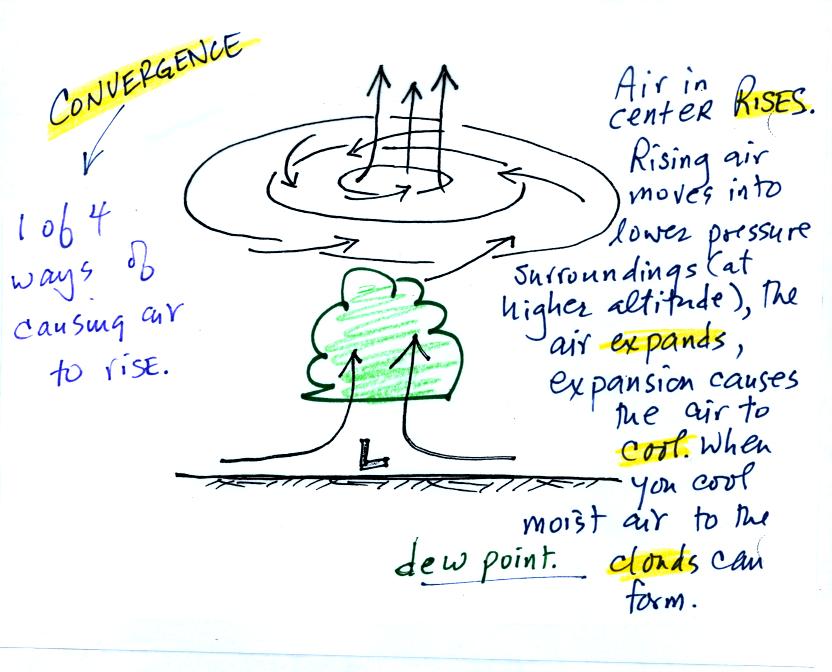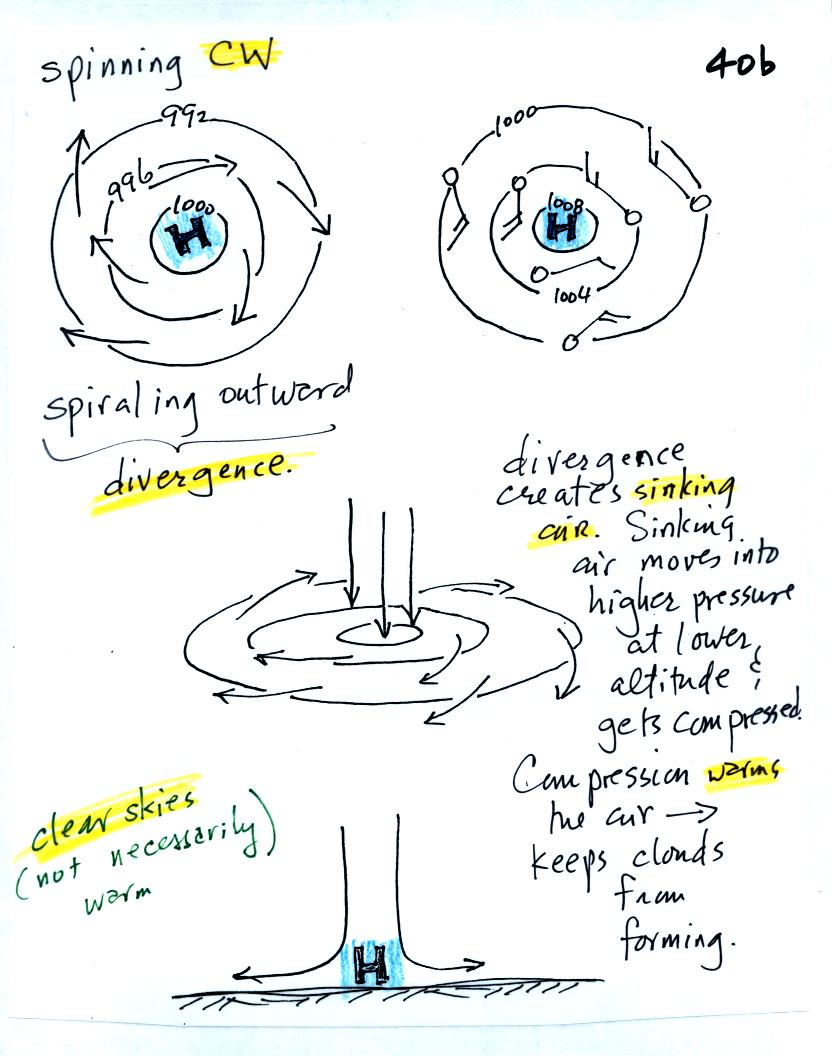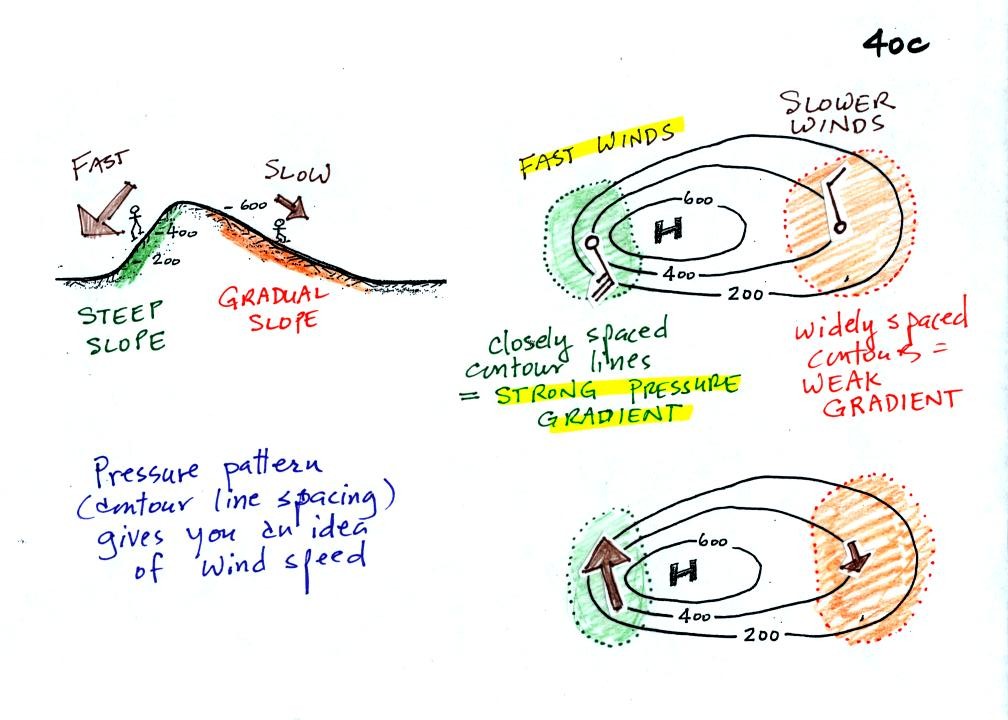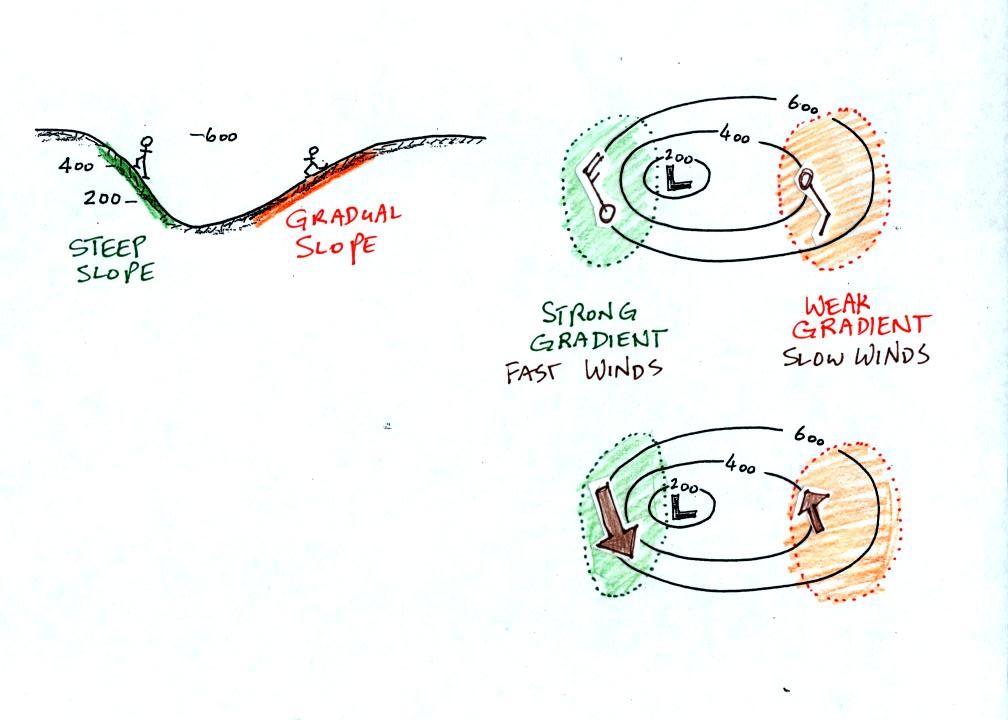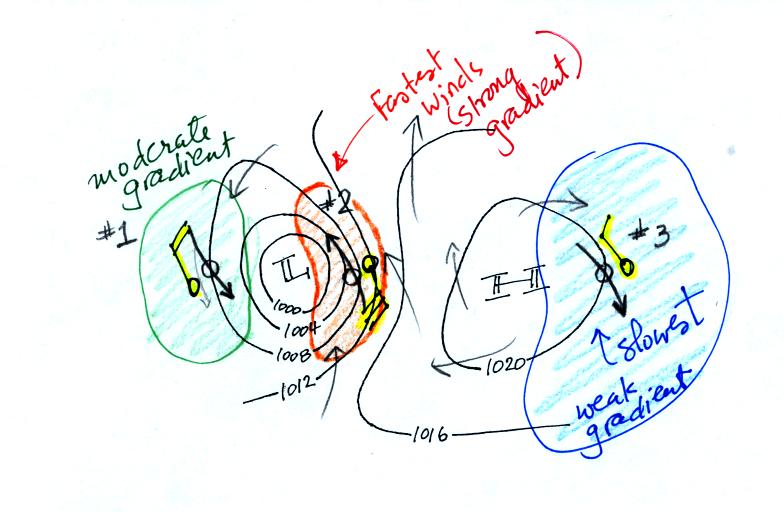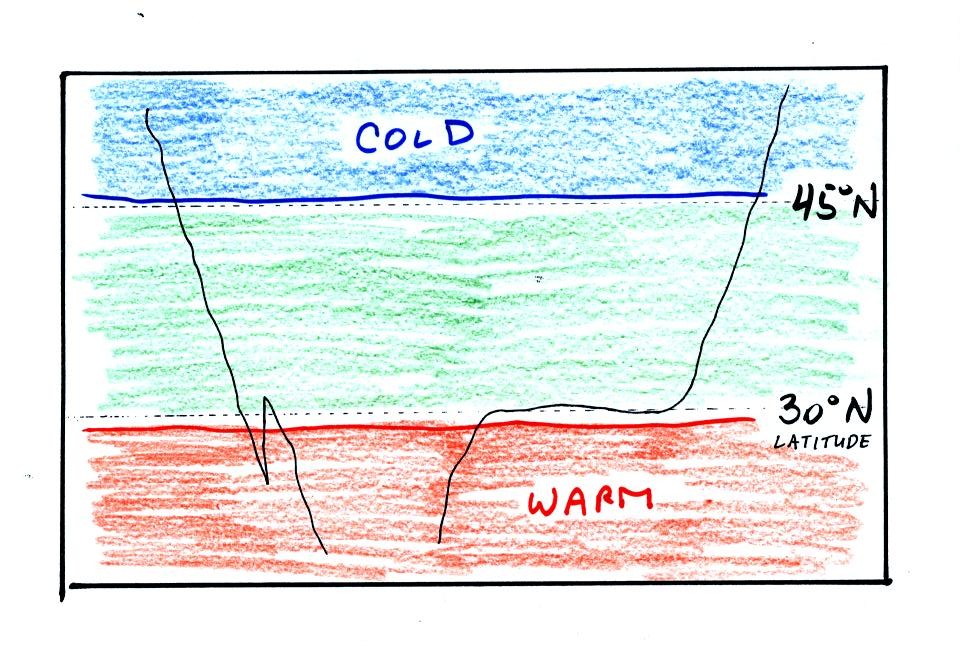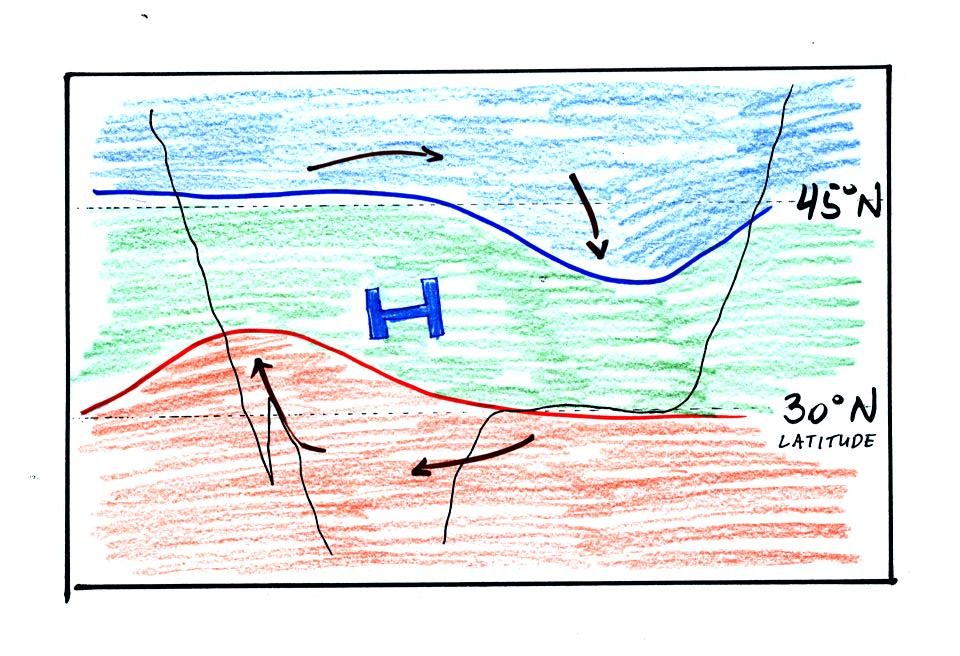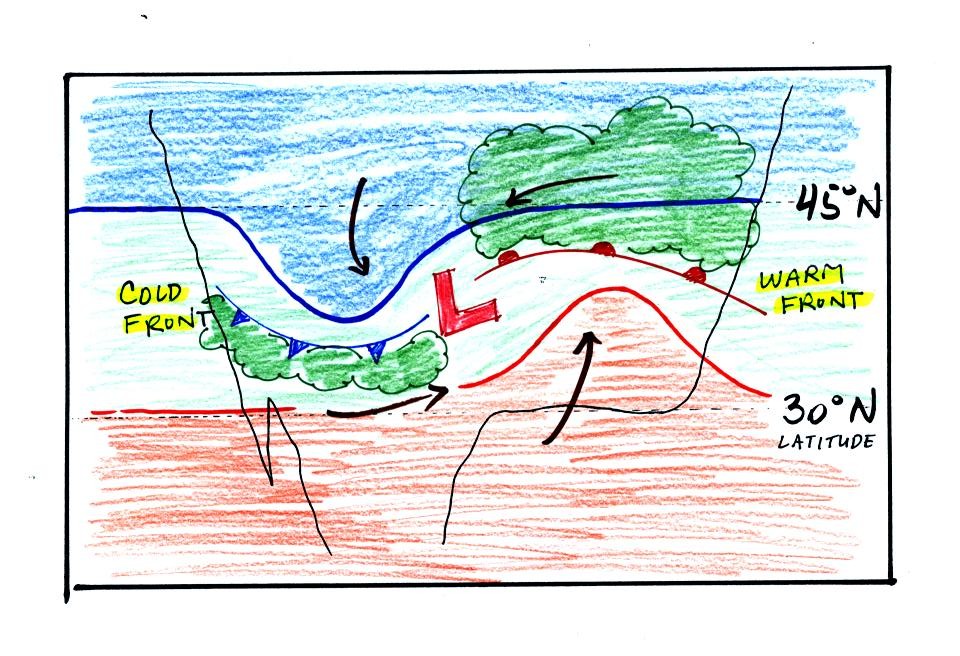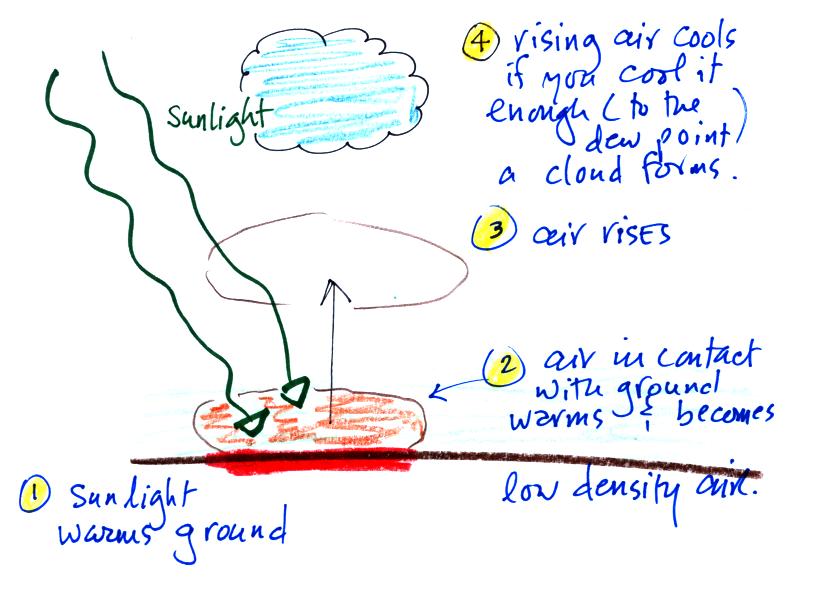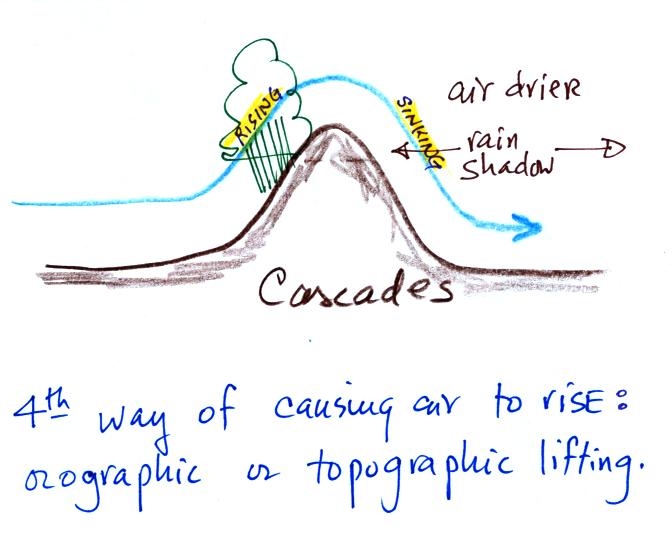Tuesday Sep. 29, 2009
click here to
download today's notes in a more printer friendly format
3 songs ( "One
Love" "Chanda
Mama" and "Stand
By Me" ) from something I just heard about a week or
two ago: the Playing for
Change Songs Around the World CD.
The quizzes have been graded and were returned in class today.
Please check the grading carefully for errors. Here are answers
to questions on one of the versions of the quiz.
Today was the first of 2 1S1P due dates. If you plan on doing a
Topic #1 report you should have turned it in today. The due date
for the Topic #2 reports has been extended until Tue., Oct. 6.
Before the quiz last week we had just learned how weather data are
plotted on surface weather maps using the station model notation.
An example is shown below (p. 38 in the photocopied ClassNotes).
Many of the pictures below are from a previous semester and may differ
slightly from the ones drawn in class (in most cases the ones below are
drawn more carefully and are neater and hopefully clearer)
Plotting the surface weather
data
on a map is
just the
beginning.
For example you really can't tell what is causing the cloudy weather
with rain (the dot symbols are rain) and drizzle (the comma symbols) in
the NE portion of the map above or the rain
shower along the Gulf Coast. Some additional
analysis is needed. A meteorologist would usually begin by
drawing some contour lines of pressure to map out the large scale
pressure pattern. We will look first at contour lines of
temperature, they are a little easier to understand.
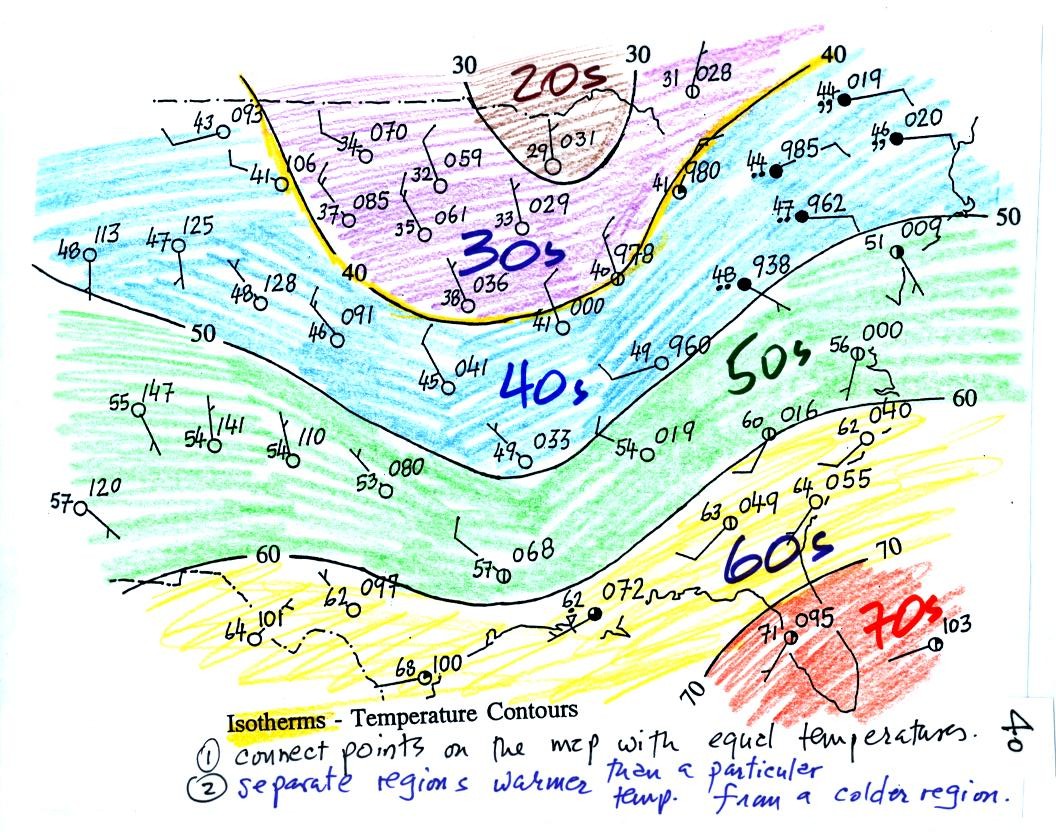
Isotherms, temperature
contour lines, are usually drawn at 10 F
intervals.
They do two things: (1) connect points on the map that all
have the same temperature, and (2) separate regions that are warmer
than a particular temperature from regions that are colder. The
40o F isotherm highlighted in yellow above passes through
a city which is reporting a temperature of exactly 40o.
Mostly it goes
between pairs of
cities: one with a temperature warmer than 40o and the other
colder
than 40o. Temperatures
generally decrease with
increasing
latitude: warmest temperatures are usually in the south, colder
temperatures in the north.
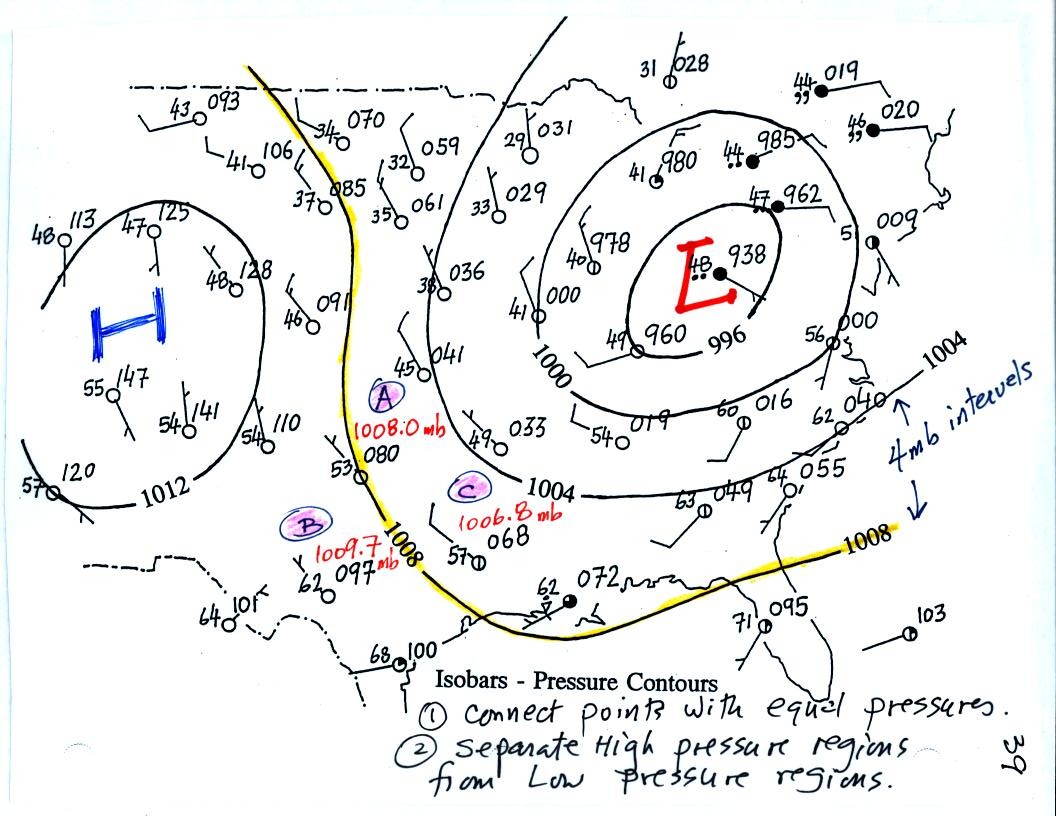
Now the same data with isobars
drawn in. Again they
separate
regions with pressure higher than a particular value from regions with
pressures lower than that value.
Isobars are generally drawn at 4 mb intervals. Isobars also connect points on the map
with the same pressure. The 1008 mb isobar (highlighted in
yellow) passes through a city at Point
A where the pressure is exactly
1008.0 mb. Most of the time the isobar
will pass between two
cities. The 1008 mb isobar passes between cities with
pressures
of 1009.7 mb at Point B and
1006.8 mb at Point C.
You would
expect to find 1008 mb somewhere in between
those two cites, that is where the 1008 mb isobar goes.
The pattern on this map is very different from the
pattern
of
isotherms. On this map the main features are the circular low and
high pressure centers.
Next we will be learning about how particular
features in the pressure pattern can affect or determine the weather in
their vicinity.
1.
We'll start with the large nearly circular centers of High and Low
pressure. A low pressure center is drawn below. Again these
figures are
more neatly drawn versions of what we did in class.
Air will start moving
toward low
pressure (like a rock sitting on a hillside that starts to roll
downhill), then something called the Coriolis force will cause
the
wind to start to spin (we'll learn more about the Coriolis force later
in the semester). In the northern hemisphere winds spin in a
counterclockwise (CCW) direction
around surface
low pressure
centers. The winds also spiral inward toward the center of the
low, this is called convergence. [winds spin clockwise around low
pressure centers in the southern hemisphere but still spiral inward,
don't worry about the southern hemisphere until later in the semester]
When the converging air reaches the
center of the low it starts to rise.
Rising air expands (because it is moving into lower pressure
surroundings at higher altitude), the expansion causes it to
cool. If the air is moist
and it is cooled enough (to or below the dew point temperature) clouds
will form and may then begin to rain or snow. Convergence is 1 of 4 ways of causing air
to rise. You often
see
cloudy skies and stormy weather associated with surface low pressure.
Surface high pressure
centers are pretty much just the opposite situation. Winds
spin clockwise
(counterclockwise in the southern hemisphere) and spiral outward.
The
outward motion is called divergence.
Air sinks in the center of
surface high pressure to
replace the diverging air. The sinking air is compressed and
warms. This keeps clouds from forming so clear
skies are normally found with high pressure (clear skies but not
necessarily warm weather, strong surface high pressure often forms when
the air is very cold).
2.
The
pressure pattern will also tell you something about where you might
expect to find fast or slow winds. In this case we look for
regions where
the isobars are either closely spaced together or widely spaced.
Closely spaced contours means pressure is changing
rapidly
with
distance. This is known as a strong pressure gradient and
produces fast winds. It is analogous to a steep slope on a
hillside. If you trip, you will roll rapidly down a steep
hillside, more slowly down a gradual slope.
The winds around a high pressure center are shown above using both the
station model notation and arrows. The winds are spinning clockwise and
spiralling inward slightly.
Winds spin counterclockwise and spiral inward around
low
pressure
centers.
This is the figure from the bottom of p. 40c. The fastest
winds (blowing from the SSE) are found in the center of the
picture. The slowest winds are found on the right side of the
figure where the contours are far apart. Note the southerly winds
in the middle of the picture would probably be warmer (because they are
coming from the south) than the NW winds at the right and left sides of
the pictures.
3.
The
pressure pattern determines the wind direction and wind
speed. Once the winds start to blow they can affect and change
the temperature pattern. The figure below shows the
temperature pattern you would
expect to see if the wind wasn't blowing at all or if the wind was
blowing straight from west to east. The bands of different
temperature are aligned parallel to the lines of latitude.
Temperature changes from south to north but not from west to east.
This isn't a very interesting
picture. It gets a
little
more interesting if you put centers of high or low pressure in the
middle.
The clockwise spinning winds
move warm air to
the north on
the western
side of the High. Cold air moves toward the south on the eastern
side of the High. The diverging winds also move the warm and cold
air away from the center of the High.
Counterclockwise winds move cold air toward the south
on the
west side
of the Low. Warm air advances toward the north on the eastern
side of the low.
The converging winds in the case of low pressure will move the air
masses of different temperature in toward the center of low pressure
and cause them to collide with each other. The boundaries between
these colliding air masses are called fronts. Fronts are a second
way
of causing rising air motions (rising air expands and cools, if the air
is moist clouds can form)
Cold air is moving from the north toward the south on the
western side of
the low. The leading edge of the advancing cold air mass is a
cold front. Cold fronts are drawn in blue on weather maps.
The small triangular symbols on the side of the front identify it as a
cold front and show what direction it is moving. The fronts are
like spokes on a wheel. The "spokes" will spin counterclockwise
around the low pressure center (the axle).
A warm front (drawn in red with half circle symbols) is shown on the
right hand side of the map at the advancing edge of warm air. It
is also rotating counterclockwise around the Low.
This type of storm system is referred to as an extratropical cyclone
(extra tropical means outside the tropics, cyclone means winds spinning
around low pressure) or a middle latitude storm. Large
storms also
form in the tropics, they're called tropical cyclones or more commonly
hurricanes.
Clouds can form along fronts (often in a fairly narrow band along
a
cold front and over a larger area ahead of a warm front). We need
to look at the crossectional structure of warm and cold fronts to
understand better why this is the case.
The top picture below shows a crossectional
view of a cold front
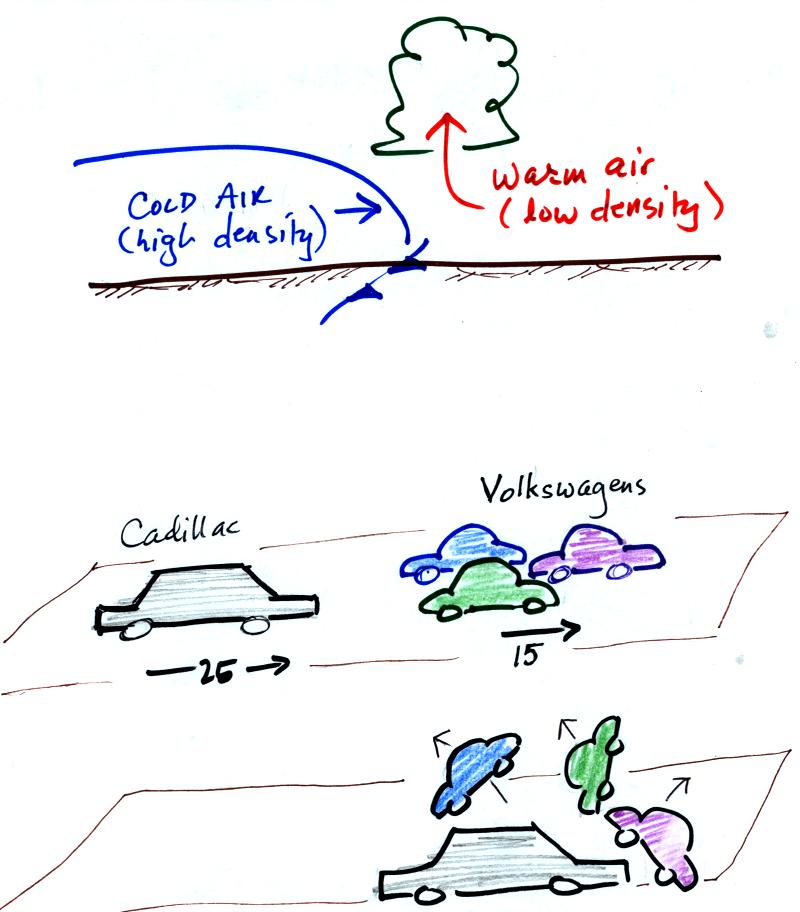
At the top of the figure, cold
dense air on the left is
advancing into
warmer lower density air
on the right. We are looking at the front edge of the cold air
mass, note the blunt shape. The warm low density air is lifted
out of the way
by the cold air. The warm air is rising.
The lower figure shows an analogous situation, a big heavy
Cadillac
plowing into a bunch of
Volkswagens. The VWs are thrown up into the air by the Cadillac.
It was at about this point that we watched a
couple of short video segments. One
attempted
to show cold dense air displacing warm lower density air like you might
see
along a cold front (the video used mixtures of water and
glycerin colored red and blue, by the way. Water with a lot of
glycerin is denser than water with only a little glycerin).
The second was a time lapse video of an
actual cold front passing through Tucson on Easter Sunday, 1999.
Clouds forming along the front edge of the front made the front
visible.
Here's a crossectional view of a warm front, the structure is a
little different.
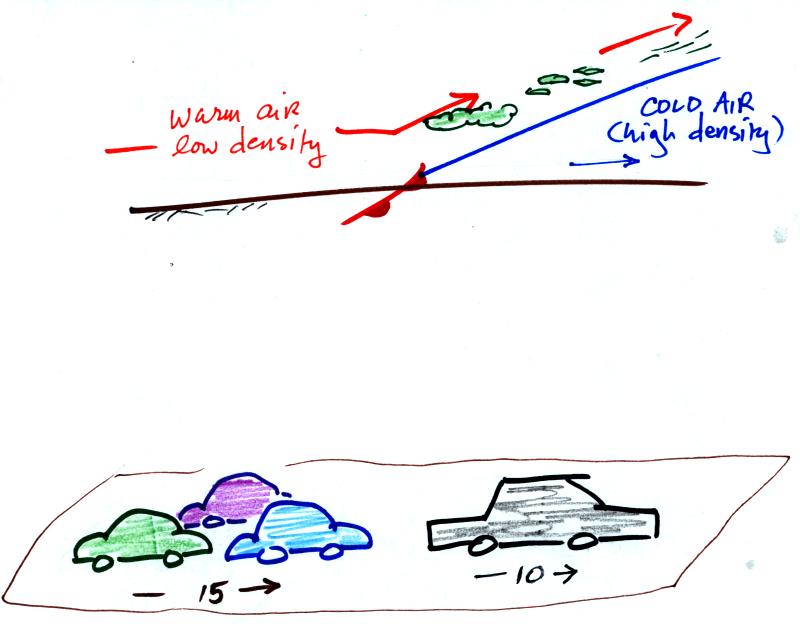
In the case of a warm
front we are looking
at
the
back,
trailing edge of cold air (moving slowly to the right). Note the
ramp
like shape of the cold air mass. Warm air overtakes the cold
air. The warm air is still less dense than the cold air, it can't
wedge its way underneath the cold air. Rather the warm air
overruns the cold air. The warm air rises again (more gradually)
and clouds form. The clouds generally are spread out over a
larger area than with cold fronts.
In the automobile analogy, the VWs are catching a
Cadillac. What
happens
when they overtake the Cadillac?

The Volkswagens
aren't heavy
enough to lift the
Cadillac.
They run up and over the Cadillac.
Fronts
are a second way of
causing air to rise. Rising air cools and if the
warm air
is moist and cooled enough, clouds and precipitation can form.
That's why the clouds were drawn in along the fronts in the middle
latitude storm picture above.
We will come back to the topic of fronts again next
Thursday.
We
will, in particular, learn about some of the weather changes that take
place as a front approaches and passes through. We will also look
at how fronts can be located on surface weather maps.
As long as
we're talking about rising air motions, free
convection is the 3rd way of causing rising air motions. This is
something we have covered already, the figure below is from the Thu.,
Sep. 17 online notes.
Topographic or Orographic lifting is the 4th way of causing air to
rise. This was discussed briefly in class in response to a
question about rainy weather in the Pacific Northwest.
When moving air encounters a mountain it must pass over
it. You often find clouds and rain on the windward side of the
mountain where the air rises. Drier conditions, a rain shadow, is
found on the leeward side where the air is sinking.
